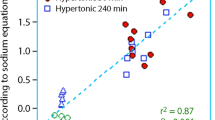Abstract
Plasma colloid osmotic pressure (COP) has been calculated from both serum albumin concentration and plasma total protein concentration. These values have been compared to those measured directly using a membrane-transducer oncometer in a group of normal subjects, in a group of critically-ill patients with a variety of primary diagnoses and in a group of hypovolaemic patients before and after plasma volume replacement with 6% hydroxyethyl starch solution. In the normal samples, COP calculated from albumin (COPalb) underestimated the measured COP (COPm) by mean of 2.0 mmHg (p(0.002), with correlation coefficient r=0.39 (n/s). Similarly, the COPalb underestimated COPm by a mean of 5.7 mmHg (p(0.001) in the critically ill patient group; r=0.38 (p(0.02). Furthermore, in the patients receiving plasma volume replacement serum albumin concentration fell by 13.1% (p(0.001) whilst COPm increased by 11.5% (p(0.002). In the normal subjects COP calculated from total protein concentration (COPtp) underestimated the COPm by 1.5 mmHg (p(0.02) with r=0.65 (p(0.01). Conversely, in the patient samples, mean COPtp overestimated COPm by 3.5 mmHg (p(0.001) with r=0.73 (p(0.002). We conclude that COPalb is an inadequate estimate of COPm particularly in patients where its use may have important clinical consequences. COPtp provides a reasonable estimate of COPm in normal subjects but in patients samples, where albumin: globulin ratio is low COPtp overestimates substantially in many cases. We advocate the direct measurement of COP in critically-ill patients.
Similar content being viewed by others
References
Landis EM, Pappenheimer JR (1963) Exchange of substances through the capillary walls. In: Field J (ed) Handbook of physiology vol II Sec 2. Williams and Wilkins, Baltimore
Poole-Wilson PA (1978) Interpretation of haemodynamic measurements. Br J Hosp Med 20:375
Rackow EC, Fein IA, Leppo J (1977) Colloid osmotic pressure as a prognostic indicator of pulmonary edema and mortality in the critically-ill. Chest 72:709
Rithalia SVS, Tinker J, Howe NA, Vence-Pastor DE (1981) A device for the routine measurement of plasma oncotic pressure. J Biomed Eng 3:71
Sprung CL, Isikoff SK, Hauser M, Eisler BR (1980) Comparison of measured and calculated colloid osmotic pressure of serum and pulmonary edema fluid in patients with pulmonary edema (1980). Crit Care Med 8:613
Torrijos JH, Larranaga FE, Rojas MEH et al. (1985) Correlation between measured and calculated colloid osmotic pressure. Crit Care Med 13:504
Webster HL (1982) Colloid osmotic pressure: theoretical aspects and Background. Clin Perinatol 9:505
Weil MH, Morisette M, Michaels S et al. (1974) Routine plasma colloid osmotic pressure measurements. Crit Care Med 2:229
Author information
Authors and Affiliations
Rights and permissions
About this article
Cite this article
Barclay, S.A., Bennett, D. The direct measurement of plasma colloid osmotic pressure is superior to colloid osmotic pressure derived from albumin or total protein. Intensive Care Med 13, 114–118 (1987). https://doi.org/10.1007/BF00254796
Received:
Accepted:
Issue Date:
DOI: https://doi.org/10.1007/BF00254796




